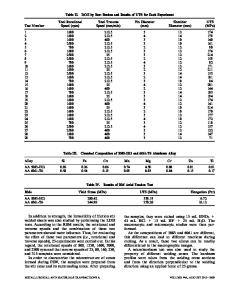A Numerical Simulation for Dissimilar Aluminum Alloys Joined by Friction Stir Welding
- PDF / 5,987,173 Bytes
- 11 Pages / 593.972 x 792 pts Page_size
- 93 Downloads / 353 Views
THE aerospace, automotive, and ship-building industries have a critical need to manufacture joints from dissimilar metals in order to produce lightweight and mechanically sound structures. However, the chemical and mechanical incompatibilities of dissimilar metals can considerably degrade weld quality during traditional fusion welding. In contrast to traditional methods, friction stir welding offers the solution to this welding dilemma, especially for those welds manufactured from aluminum-based alloys joined to other aluminum-based alloys. Friction stir welding utilizes much lower heat input than traditional welding methods and achieves the joining process in solid-state, thereby avoiding the microstructural and mechanical complications that can accompany melting and resolidification during fusion welding. Although friction stir welding has significantly matured as a manufacturing technology, research and developments efforts have primarily focused on the welding of the same metallic material.[1,2] Producing high-quality, defect-free joints CARTER HAMILTON, Associate Professor, is with the Department of Mechanical and Manufacturing Engineering, College of Engineering and Computing, Miami University, Oxford, OH. Contact e-mail: [email protected] MATEUSZ KOPYS´CIAN´SKI, Research Scientist, and STANISŁAW DYMEK, Professor, are with the Faculty of Metal Engineering and Industrial Computer Science, AGHH University of Science and Technology, Krako´w, Poland. ALEKSANDRA WE ˛ GLOWSKA, Research Scientist, and ADAM PIETRAS, Director, are with the Department of the Testing of Materials Weldability and Welded Construction, Institute of Welding, Gliwice, Poland. Manuscript submitted November 23, 2015. METALLURGICAL AND MATERIALS TRANSACTIONS A
from dissimilar metals and numerically simulating this process, therefore, remains a major research opportunity to the manufacturing community.[3] DebRoy et al.[3] and Murr[4] provided the first systematic and comprehensive literature surveys regarding friction stir welding of dissimilar alloys, and Kumar et al.[5] recently reviewed and compiled the current state of knowledge regarding this topic. The primary difference between the friction stir welding of similar and dissimilar alloys is the discontinuity in properties which promote an asymmetry in heat generation and material flow during welding across the abutting surfaces. Even selecting which material is used for the advancing side workpiece and which is used for the retreating side workpiece substantially contributes to the asymmetry in joint properties. The unique deformation behaviors of the dissimilar materials and the differences in physical properties, such as viscosity and thermal conductivity, clearly pose a unique set of challenges that must be solved. These challenges also present themselves when attempting to simulate the joining process particularly in regard to the material flow and temperature distribution. Numerous researchers have successfully modeled the material flow behavior, the temperature distribution, and the microst
Data Loading...











